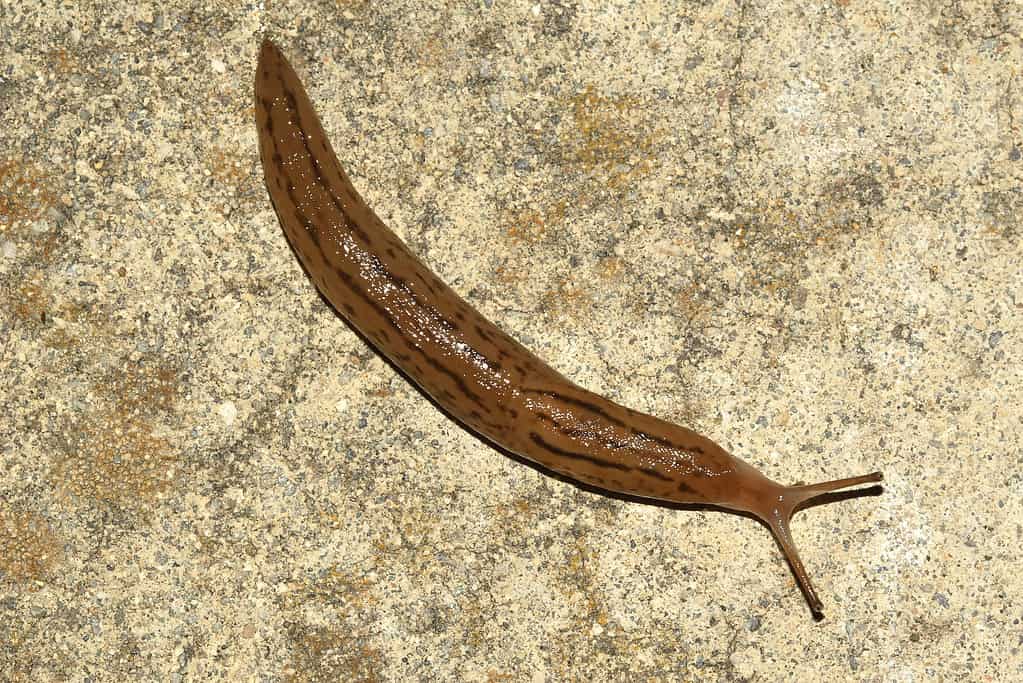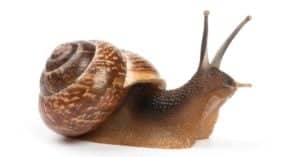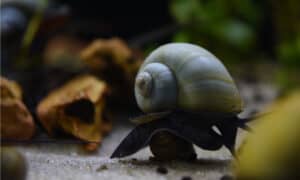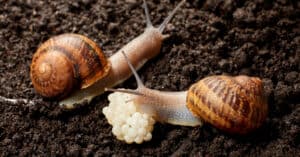The slug and the snail are part of the Gastropoda class under the phylum Mollusca. The classification is a combination of the Greek words gastros (stomach) and podos (feet). In general, gastropods are aquatic. You’ll find snails and slugs on dry ground, though both creatures can certainly be in the water, even if for short periods.
Both animals leave a trail of slime. It’s mucus that allows them to move along the ground. Either creature can lose moisture to dry soil, dehydrating them in harmful ways. The release of mucus prevents moisture loss. The substance also prevents cuts from sharp objects in the soil.
The mollusks are similar. Both have slender tentacles with eyespots on the end. Their mouths are directed downward. They have broad, singular, flat bottom, muscular feet covered with epithelial cilia and lubricated with mucus.
Unfortunately, most people see these creatures as annoyances. Slugs and snails eat fruit and plant leaves, roots, and stems. They will completely destroy gardens.
Both animals are slow-moving and there are over 60,000 species combined of slugs and snails.
Yet, despite their similarities, the snail and slug are different. Let’s take a closer look at these animals in a snail versus slug review.
Comparing Slug vs Snail
In the following chart, we summarize a number of the major differences between the snail and slug.
| Slug | Snail | |
|---|---|---|
| The name slug is actually applied to any gastropod mollusk that doesn’t have a shell, a reduced shell, or a small internal shell. | In the gastropod mollusk world, the snail is noted for its coiled shell. This shell develops in the adult stage. There are also different types, including land snails, sea snails, and freshwater snails. | |
| Shells | Lacks a hard exterior shell. They may have an internal shell or a reduced shell. | Has a coiled, large exterior shell that the snail can retract into. |
| Size | Up to 15 inches | Up to 10 inches |
| Lifespan | 1–6 years | 2–3 years in the wild Between 10–15 years in captivity |
| Speed | Based on the species of slug | Though speed can differ, the common snail covers in the vicinity of one millimeter a second. |
| Behavior | Nocturnal in nature, the slug feeds at night on plant life. | Snails spend most of their time in search of food. Land snails are either omnivorous or herbivorous. A few species are predatory. |
| Movement | Slugs move at an exacting slow pace. | Watching them closely, snails might appear to be moving on several feet. Truth is that’s a contraction of the muscles. They only use one foot. |
| Environment | Slugs prefer dark, cool places that are moist. They hide during the day and thrive in the spring. This can lead to serious damage to plants early in the season. | Snails reside in dirt and soil, sand, under rocks and leaves, in trees, and in bodies of water. Land snails do not breathe underwater and can drown. |
The 3 Key Differences Between Snails and Slugs
Here are the most significant ways to tell the difference between a slug and a snail.
1. Slug vs Snail: Anatomy
The key difference when you see one of the creatures is the snail has a noticeable shell while the slug has none.
The snail’s shell is large enough for the creature to duck into for defense. Some snails have the capacity to close the shell once they’ve retracted.
Slugs have no mobile home or defensive shell. Many slugs use an internal vestigial shell. It’s used to store calcium. With no protective shell, the animal’s soft tissue is at risk of desiccation.
2. Slug vs Snail: Speed
Snails and slugs travel at different speeds. The common snail can hit one millimeter per second. This is faster than most slugs. There are snails that do not move at all. They sit at the bottom of the sea, feeding on plankton that drifts in their area.
3. Slug vs Snail: Habitat
Snails and slugs can live in nearly every habitat on the planet, including salt and freshwater. They favor moist environments such as moss, tree bark, piles of damp refuse, and rotting logs.
Slugs, which aren’t protected by a shell, are vulnerable to desiccation during particularly dry seasons.
With no shell on their back, slugs easily — if slowly — maneuver into the smallest spaces with the added ability to compress themselves. They use wooden boards, stone slabs, and loose tree bark to their advantage.
Snails quickly hide in their shells, especially when natural predators are around. There are snails that can retract and close the shell for extra protection.
Cuisine
Consuming snails is a delicacy in many countries but especially France. Escargot, the dish of cooked land snails, is an appetizer in many fine dining establishments. Large, land snails are primarily sourced for the dish, mainly because they are highly nutritious, and not marine snails, which can be toxic to humans, so better to not risk it.
Slugs can also be consumed as a nutritious snack, or dare. When eating slugs, it is best to cook them thoroughly, as most land slugs and wild snails carry certain parasites.
Summary: Snail vs Slug Differences
| Factor | Snail | Slug |
|---|---|---|
| Habitat | Dirt, sand, rocks, some in water | Dark, cool, moist places |
| Behavior | Search for food 24/7 | Nocturnal, feed at night |
| Anatomy | Shell | No shell |
| Lifespan | 2-3 yrs in wild | 1-6 yrs |
Are Slugs Harmful?

Slugs can carry parasites that can make you or your pets ill.
©Sanjay Acharya, CC BY-SA 3.0 – License
It may not seem like it, but surprisingly, slugs can cause a significant amount of harm to people and pets. People should be careful when they eat anything from a garden that slugs may have crawled on, as it may contain the slime of contaminated slugs, and this is another reason it is important that you wash anything before consumption. If a person accidentally ingests a raw slug, they may also be susceptible to lungworm larvae that are found in slugs, as well as snails.
Pets are also susceptible to unpleasant effects from slug slime. Should a dog or cat ingest this mucus, it can induce vomiting or excess drool. Additionally, some slugs carry the rat lungworm parasite, which can be transferred to your pets should they eat one.
The photo featured at the top of this post is ©
FAQs (Frequently Asked Questions)
Can a snail become a slug?
Actually, science accomplished this. In 2010, a team of biologists redesigned the shape of snails. They reprogrammed the growth direction of the mollusks’ shell-generating tissue in the period when a freshwater snail begins to form its outer shell. The process prevented the development of the shell. In the end, they had what was basically a slug. But Mother Nature has never seen fit to transform snails into slugs or vice versa.
Are slugs worse than snails?
There’s no way to determine if there is a “worse” between the snail and slug species. They are both dangerous to your lawns and gardens. They love well-maintained greenery where they can hide, nest, and feed.
Do slugs and snails feel pain?
The slug has a highly developed nervous system. The fastest way to get rid of them is to pour salt on the creature. This rapidly dehydrates (burns) the slug and you can see them trying to escape, writhing because of the pain. The slug even flinches if it walks into an object. As for the snail, researchers say their nervous systems do not process emotional information, so they do not experience suffering.
Is snail venom really used as a medication?
There are conotoxins in snail venom. The snail uses it for capture and defense. The element contains bioactive peptides used in pharmacological resources. It’s believed these elements could become a new classification of analgesics.
Do snails bite?
Yes, they do. On average, they have 14,000 teeth. Only because of their size and lack of force, you don’t feel it. It’s said the bite feels like a scrape on the skin with a tiny brush. But there are wild snails that can inflict a painful bite.
Thank you for reading! Have some feedback for us? Contact the AZ Animals editorial team.






